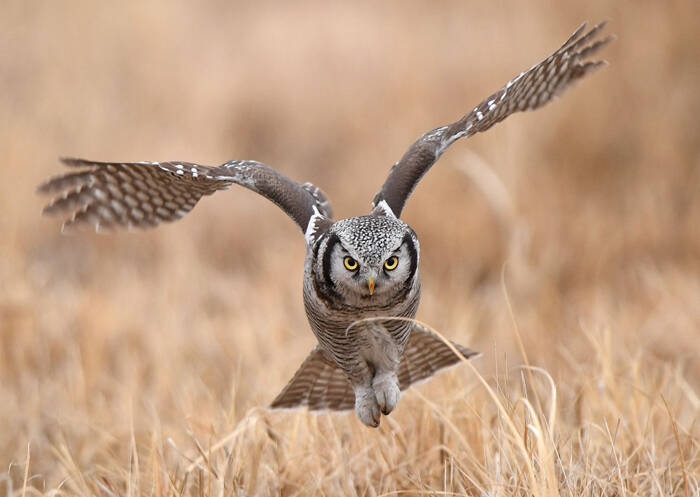Surnia ulula
IUCN
LCBasic Information
Scientific classification
- name:Surnia ulula
- Scientific Name:Surnia ulula,Northernhawkowl,Dogchin-Ugel, Eagle Owl, Owl
- Outline:Raptor
- Family:Strigiformes
Vital signs
- length:35-40cm
- Weight:247-375g
- lifetime:No verification information
Feature
The overall feather color looks quite eye-catching, and is different from other nocturnal owls in both body shape and feather color.
Distribution and Habitat
The fierce owl is found in northern Europe, Russia, Alaska in the United States, and Canada.
In China, it is distributed in Oupu, Huma, Wuiling in northern Heilongjiang, Manjiang in Jilin, Boktu, Wuerqihan, Xing'an in Hulunbuir League in Inner Mongolia, and western Xinjiang and Tianshan.
The fierce owl lives in primitive coniferous forests and mixed coniferous and broad-leaved forests. It also appears in forest tundra and forest areas on plains. It especially likes open areas in the forest, logging sites, streams in the forest, and shrubs beside streams at the edge of the forest.
Appearance
There are no ear tufts. The ear feathers are white with black tips and a crescent-shaped black spot behind them surrounding the white face. The facial disc is not obvious. The tarsus and toes are covered with white down feathers. The tail feathers are long. The body shape is similar to that of falcons. The upper body is brown with white spots, and the lower body is white with brown horizontal stripes. The overall feather color looks more eye-catching, which is different from other nocturnal owls in body shape and feather color. This is because the Arctic region where it lives has almost continuous daylight throughout the summer. The iris is bright yellow; the bill is yellow, and the claws are black.
Details
The Northern hawk owl is a medium-sized bird with three subspecies.

The Northern hawk owl can move and forage during the day, especially in the early morning and evening. The call of "hu, hu" is relatively monotonous, but very pleasant to the ear. It flies quickly, sometimes flapping its wings and sometimes gliding, often alternating between the two, especially when foraging. When resting, it mostly perches on the top of trees or electric poles, and swoops down when it sees prey. Sometimes it also hunts in flight, or flies close to the ground and pounces on prey, or glides in the sky and swoops down after finding prey. Its call is similar to that of eagles. It mainly feeds on rodents.
The fierce owl is a winter migratory bird in the northeast and a summer migratory bird in Xinjiang.
The breeding season of the fierce owl is from April to July. It nests in the holes at the top of dead trees, and also uses the old nests of birds such as crows and magpies. Each nest lays 3 to 13 eggs, mostly 3 to 9 eggs, and the number of eggs in a nest varies greatly. The size is 36 to 44 mm × 29 to 34 mm. After the first egg is laid, the female bird begins to incubate the eggs.
It is one of the endangered species in the world and one of the species on the United Nations' List of Endangered Wildlife.
It is listed as a second-class protected animal in China.
Protect wild animals and eliminate game.
Maintaining ecological balance is everyone's responsibility!








